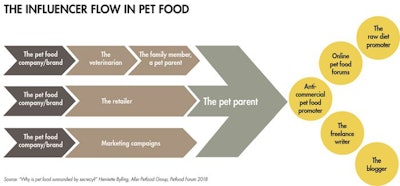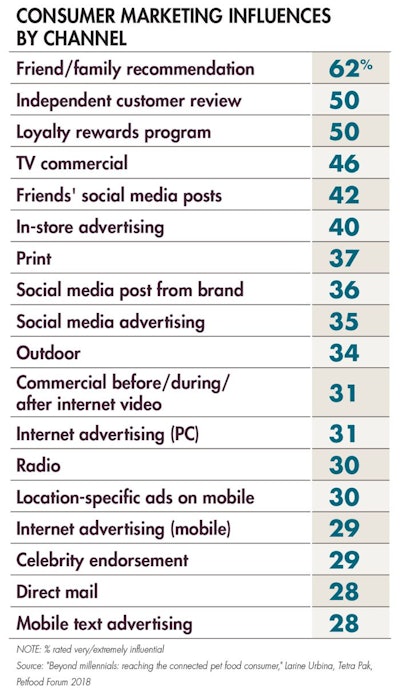
Transparency is a hot topic in the pet food industry these days. It’s also a complex one. Pet owners want to know what’s in the pet food they’re buying, but product labels and nutrition statements can leave them feeling confused or overwhelmed. Making a claim as simple as “all natural” isn’t simple at all if the individuals of a target audience have different personal understandings of what the phrase means. And with the internet wide open to influencers with varying degrees of pet food knowledge, it can sometimes feel like the industry is fighting a battle on multiple fronts, all in the name of transparency.
“I believe 'transparency' is in the early stages of understanding, but I believe there is a ceiling with respect to what a consumer will perceive as transparent versus what the pet food company is willing to provide or able to provide in order to claim they are being transparent, ethical or accountable for that matter,” said Jeremiah David, CEO of Pureluxe Pet Food. “The abundance of information on the internet, combined with recalls and third-party bloggers/social media groups are setting the tone for us to take part in some level of transparency or be left behind. More and more customers are wanting to know more about the brands they trust in terms of their social responsibility, ethics in business, accountability and transparency.”
The issue of the pet food industry influencer
On the surface, transparency seems like a fairly straightforward idea. Let your customer know what’s in the food they’re buying, perhaps where the ingredients came from, and give the customer enough information about your company to feel good about doing business with you and your products. In reality, though, there is another aspect to transparency that may be the most important — and most complicated — of all: education.
“We had a very powerful position (10 years ago), a position we can only dream about now because we cannot control the information in the way we could back then,” said Henriette Bylling, CEO and owner of Aller Petfood Group. Bylling spoke on transparency (“Why is pet food surrounded by secrecy? The quest for transparency”) at Petfood Forum 2018, held in Kansas City, Missouri, USA, in April. “Those days are over,” she said.
According to Bylling, an increased number of influencers, such as freelance writers and bloggers, means those in the pet food industry simply can’t control their brand or product messages as well as they used to (see Figure 1). Ignoring that reality could spell disaster for the pet food industry.

FIGURE 1: The influencer flow used to be fairly straightforward in the pet food business, but with the addition of the internet and all its component parts, opinions of all sorts flow far more freely to consumers.
“A lack of transparency from us, pet food producers, means that we are leaving the influencers to their own devices,” said Bylling. “And we’re increasing the likelihood of Google leading the pet parent to incorrect or biased information. If we don’t share ‘top secret’ pet food information, pet parents and other stakeholders will make up their own ‘truth’ and potentially expect the worst.”
How to influence the influencers and educate pet parents
One of the most significant ways to reach out to pet parents today is through online social media, according to Larine Urbina, vice president of communications for Tetra Pak U.S. and Canada. Urbina spoke at Petfood Forum 2018 on “Beyond millennials: reaching the connected pet food consumer.” The connected consumer is well-adjusted to being online and spends a significant amount of time conducting business of all kinds via the internet. According to Urbina, connected consumers spend at least four hours online every day. They actively engage with brands online (58 percent access branded content on social media) and want to be involved (48 percent use social media to express an opinion about brands and products).
“There is a shift from traditional media to online forums, blogs and social media,” said Urbina at Petfood Forum. “User-generated content is more influential and popular than ever.” In fact, 51 percent of connected consumers trust personal experience, versus 49 percent who trust data, and social media is seen as substantially more believable (with 62 percent trusting it) than advertising (with just 38 percent of consumers trusting it), according to Urbina (see Figure 2).

FIGURE 2: The marketing influences the pet food industry has at its disposal are more plentiful than ever. On the other hand, having so many channels of influence can make it difficult to determine how to best reach the customer.
Communicating with consumers is about more than education, it’s about empowerment, said Urbina. Empowered consumers adapt their behavior, and providing them with the information they need (i.e., creating awareness) will bring about consideration on their part, which could lead to conversion (trust of the brand), loyalty (will purchase the brand above other options) and even advocacy (will promote the brand to others in their own spheres of influence). Through this lens, it’s easy to see how educating particularly strong influencers could become a vital part of a company’s marketing strategy.
The future of pet food transparency
The pet food industry is in the middle of creating a new baseline for what it means to be transparent, and a lot of internal steps must be taken to get everyone on the same page before external factors can come into play.
“I believe that more and more companies will provide more details about what makes them 'tick' by which their existing and future customers can relate to and motivate them to continue to be loyal to their brand,” said Davis. “I believe that the factories who co-pack most of the high-end, unique brands seen on the shelves can dictate what they will and will not do for a brand and force the brand to be accountable for their actions or lack of action. At the same time, they can accept some accountability for the brand they co-pack by putting their seal of approval on things as basic as verifying that the formula matches the package label.”
Once the industry is in agreement about what it means to be transparent, the real work — that of reaching out to and educating pet parents and influencers — can begin.


















